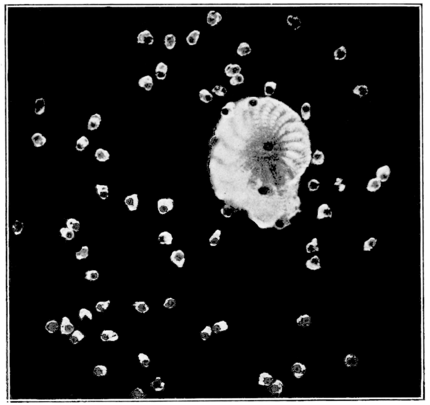account, verified by Winter, the protoplasm of the microsphæric individual breaks down into small fragments, each fragment enclosing a number of these granules of chromatin, which coalesce later to form one single nucleus. If we accept Lister's account the coalescence occurs before the breaking down of the protoplasmic mass. All observers agree, however, that hundreds of minute nucleated "embryos" arise
Fig. 7. Polystomella crispa. Liberation of pseudo-podiospores from the megalosphæric individual.
by fragmentation of the parent protoplasm (Fig. 7). The breaking down of the original nuclei is an important step, for by this process the important germ plasm is formed, which in the finely granular state described was named by Hertwig the chromidia.
The small "embryos" leave the parent organism in swarms (Fig. 8), and the calcareous shell is finally deserted. Each "embryo" then grows into a megalosphæric or large-chambered individual in which the primary nucleus remains single for a considerable period. New chambers are formed about the primary central chamber and a new adult individual results from the continued growth. The history of the nucleus, however, is quite different from that of the microsphæric individual. The protoplasm contains a large primary nucleus which ultimately degenerates and disappears. During life of the individual, however, this nucleus gives rise by chromatin "secretion" or by fragmentation, to an immense number of minute nuclei which are distributed throughout the protoplasmic mass. Each nucleus becomes

